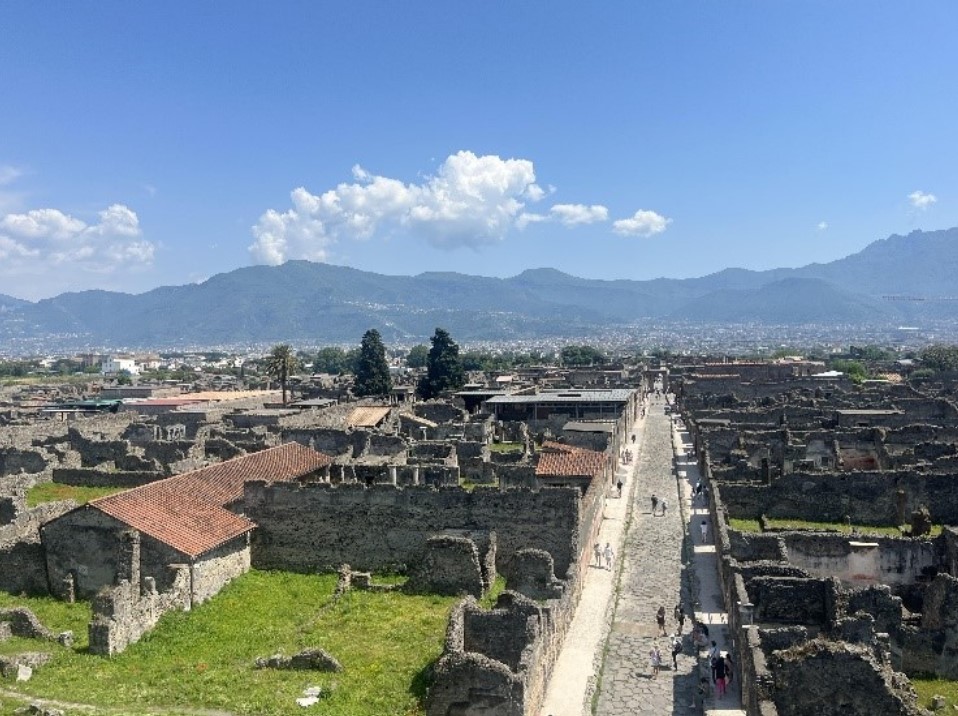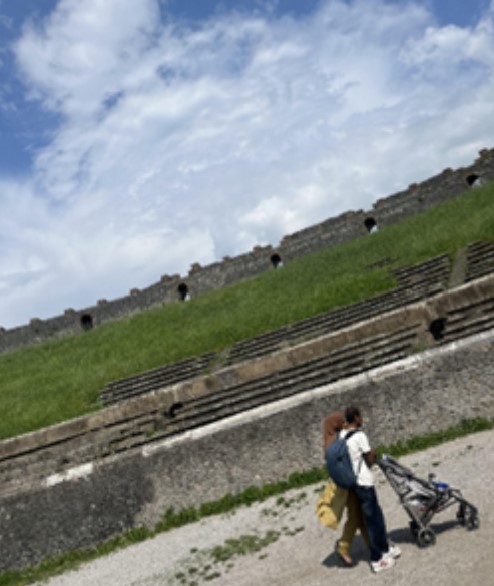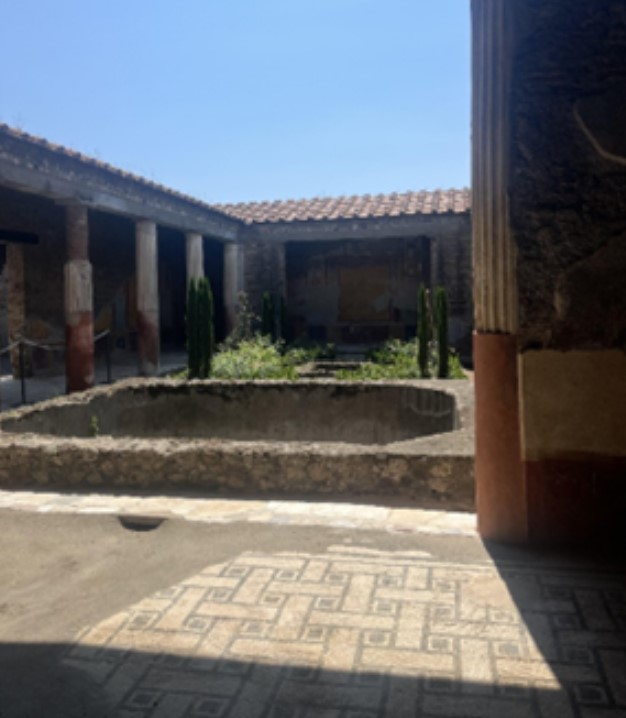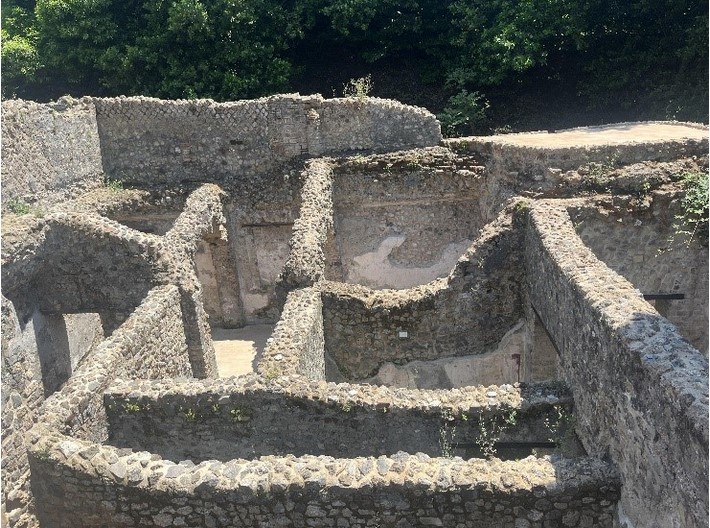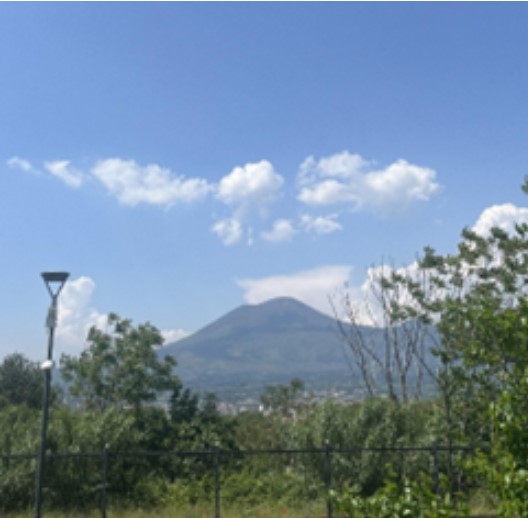Tags
BGSU History, BGSU Study Abroad, Casey Stark, Jo Enger Arthur Scholarship for Study Abroad, Maggie Fuller, Pompeii, Roma Aeterna, Social history, Undergraduate
By: Maggie Fuller, BGSU Roma Aeterna 2023 Student
In history, one of the most relevant topics is colonization. I spent three weeks abroad in Italy studying Ancient Roman history in the summer of 2023. In my time in Italy, I occasionally noticed a lot of historical emphasis on the so-called Roman account of events. The perspective of history from groups who have been colonized by Rome is lacking. When looking at Pompeii, the ancient Roman city massacred by the volcano Mt. Vesuvius, historians note that the city was thriving at the time of its destruction. But who determines if Pompeii was thriving: The Romans, or the descendants of natives who inhabited Rome pre-colonization? The interpretation of the definition of thriving also changes the understanding of events. There are 158 years between the colonization of Pompeii and the eruption of Vesuvius. This gives a lot of time for traditions and cultures to be lost, especially with the shorter lifespans people had in ancient times. But with evidence through archaeology and recovered findings, a lot of the culture wasn’t lost. This proposes several questions about the lifestyle of the citizens of Pompeii. Were Pompeiians rejecting Roman cultural changes? Did they want Pompeii to become a symbol of wealth for Roman elites? Rome established an importance on social cohesion, but how could a society be unified if the colonizers are living in wealth and extravagance and the colonized are in poverty? This article will argue that the Romanization of Pompeii established that social cohesion was frugal and only existed in pre-established social classes. The wealth divides in Pompeii were correlated to the divide between indigenous descendant citizens and Roman citizens.
One contribution to the stability of Roman society was the emphasis on social cohesion. I was able to observe this significant priority during my time in Rome. Many public buildings gathered Roman society together for a common purpose. Whether that purpose was bathing or entertainment, each of these aspects unified individuals in society. Additionally, the structure of the Roman government significantly emphasized citizen involvement. Unity amongst citizens was treasured highly as it contributed to shared prosperity and collective wealth. When looking at colonies that Rome conquered, this social cohesion becomes lost. Cohesion became valued under Augustus’ Principate which formed a strong imperial government. Augustus combatted the prior inequalities in structure by introducing “forces of cohesion such as family and household, structured vertical and horizontal relationships between individuals and households, and the ideological apparatus of the state” (Garnsey, et al., 131). While society stayed hierarchical, each class and group of people could unite through this cohesion. With the Principate of Augustus, Rome continued to develop and introduce public projects that would benefit and unify society and contribute to this cohesion. While there was some time in Pompeii when Augustus was not in power, the city was a part of Rome for the entirety of Augustus’ reign and afterward.
It is easy to look at the infrastructure of Pompeii and establish that the city was very well off with its public buildings. One could argue that these public buildings such as political centers, basilicas, amphitheaters, and others are a sign that cohesion was prevalent in Pompeii, as there are locations intended for public usage which supplied equal opportunities to the lower classes. But many buildings were constructed before colonization and only were added to and improved on after colonization. The comitium, a public space for assemblies, was expected to be built before citizens of Pompeii could be granted Roman citizenship. Many temples and structures that benefited the population of Pompeii were constructed with Roman assistance. In Paul Zanker’s book, Pompeii: Public and Private Life, he estimates that “there must have been at least 2,000 veterans” not including their families and dependents, retiring in Pompeii. Some of these veterans were antagonists to Pompeii, retiring and living with the people they had just fought against. Rome then started “the redistribution of land, existing houses, and building sites” and confiscated property to be reallocated for the veteran’s benefit (Zanker, 62). So the new construction projects in Pompeii weren’t exactly for the Pompeiians. I was lucky enough to visit the well-preserved amphitheater in Pompeii, as shown in Figure 2. The amphitheater was constructed during the colonial years and was quite impressive. But, “such an amphitheater must have primarily served the needs of the veterans.” Although Pompeiians could attend shows, the theater was constructed for the veterans to have a taste of home. Zanker states that “one can’t help wondering whether the townsfolk really had any chance of obtaining good seats” (Zanker, 71-2). So regardless of the construction that Rome contributed to Pompeii, it wasn’t made in the interests of the Pompeiians.
Housing in Pompeii was separated into three classes: Villa for the rich, Domus for the ‘middle class,’ and insula for the rest of the population. Villas were commonly vacation spots for wealthy Roman citizens traveling to Pompeii to spend the hot summer months. Despite only being seasonally occupied, these villas had many luxurious features. These features expand from numerous rooms to personal fountains or fishponds. The decorative nature of the villas can be seen in Figure 3. The most luxurious feature was the private baths. Archaeologists found that “the majority of private baths in Pompeii [were constructed] between 40 and 20 B.C.” This is significant as this was before the introduction of aqueducts and pressurized water in Pompeii. The villas containing private baths symbolize wealth as water sharing was illiberal before pressurized systems. This period also showed little decorative usage of water through fountains as this was costly and not prioritized. As pressurized water began to be introduced, it was still a luxury, so fountains or pools were owned by the wealthy (Jones, 697). While on the opposite side of the spectrum, the domus or insula did not have private baths. They also had very few rooms but doubled the occupancy. Insula housing structures could be more commonly compared to apartments. They would be several floors tall to house more families. Most of these buildings were not that exciting to walk through because of the lack of decoration. I noticed a lot of them appeared more damaged, but the reality was they were poorer quality buildings. It was interesting seeing the decay. They were built with inferior material which decomposed faster and looked less appealing. This can be seen in Figure 4, looking above an insula that would have been several stories high. We went into many more villas since they were more intact and had more to look at.
The vast differences in elements of housing are a clear, unarguable, class divide. What can be argued is the way these villas were created upon romanization, for the Romans. Pompeii was colonized by Rome in 80 BCE. Before this, Pompeii had gone through numerous changes in authority. Rome conquered Pompeii during the Roman-Samnite wars. Before Pompeii was controlled by the Samnites, it was under Oscan and Etruscan influence. The Samnites expanded Pompeii and fortified the city. Pompeiians fought alongside the Samnites in the Roman-Samnite wars and were against Roman control. Roman control changed the native language from Oscan to Latin and implemented much of Roman culture into Pompeii. This signifies cultural erasure from the Oscan and Hellenistic influences on Pompeii. This is not to be taken lightly by any indigenous descendant now sharing their space with elite Romans. There would be “tensions and conflicts […] between the Oscan Pompeiians and the veterans,” these tensions were derived from cultural differences. The veterans “had different leisure time interests, and exhibited different social behavior.” The differences in social behavior weren’t understood by the Pompeiians as they had prided the Hellenistic aspects of their culture (Zanker, 62). It was hard to clash with cultures and accept a new culture taking over.
One sign that ancient scientists would not have gathered was that the earthquake that took place on May 2nd 62 C.E. was a sign of Mt. Vesuvius’ eruption. This was recorded by Tacitus in Book 15 of the Annals. Tacitus remarks how “in an earthquake much of the populous Campanian town of Pompeii collapsed” (Tacitus, 15.22). Note how Tacitus considers Pompeii more of a Campanian town than that of a Roman town. This signifies that Pompeii was understood by Romans to be more in touch with its original culture than with Roman culture. Back to the topic of the earthquake, the understanding of the correlation between earthquakes and volcanic eruptions was not yet established. This earthquake devastated Pompeii significantly and destroyed many buildings in its process. I noticed during my visit to Pompeii that some destruction was not the result of the eruption. For instance, in the Forum some buildings had missing carved marble decorations. Zanker confirms in his book that this was the result of the earthquake, not of the volcano. There is also the possibility that another earthquake hit Pomepii in the seventies which may not have been documented. The earthquake’s destruction is significant because seventeen years passed between the earthquake destroying buildings and décor and the eruption of Vesuvius and repairs had not been made. The wealthy Romans traveling to their villas seasonally did not need to repair public buildings or apartments for the lower class. There was no evidence of destruction to the villas which indicates either they were not affected by the earthquake, or they had been fully restored before 79 C.E. This would be likely as the elite homeowners could afford to restore their homes, and the lower class could not. This further emphasizes that public buildings were constructed before Roman colonization, and as a colony, many buildings weren’t made for the Pompeiians.
As time goes on past the initial stages of colonization, it can be assumed that the integration of societies and cultures helped social cohesion. But it would not be destroyed entirely. Romans took over Pompeii, altering its culture and making it lose aspects of its Oscan culture. The Romans then used Pompeii to house retired veterans and wealthy elites wanting a vacation house in a cooler area. They built culturally Roman structures for the Romans, and only later on would they allow the Pompeiians to indulge in them equally. The social cohesion that Augustus had vouched for was not applicable in Pompeii. Rome had little consideration for the integration of its colonies. Instead, colonies are seen as faraway lands, barely even Roman. The Pompeiians may be Roman citizens, but they would not be viewed as such. Social cohesion cannot exist in a society where the priority is on the colonists, not on the indigenous population. So Pompeii was not in as great of a state as we had understood it to be. That information was strictly from a Roman point of view. We can observe the luxuries that the colonists were enjoying, but that excludes the fact that the Oscan Pompeiians and their descendants were not enjoying the same luxuries. Pompeii may be a culturally significant town, but not without acknowledging the cultural erasure Rome had inflicted upon them.
Works Cited
Fuller, Magdalena. Pompeii. 28 May, 2023. Photographs.
Garnsey, Peter, Richard Saller, Jaś Elsner, Martin Goodman, Richard Gordon, Greg Woolf, and Marguerite Hirt. “The Social Hierarchy.” In The Roman Empire: Economy, Society and Culture, 2nd ed., 131–50. University of California Press, 2015. http://www.jstor.org/stable/10.1525/j.ctt9qh25h.15.
Jones, Rick, and Damian Robinson. “Water, Wealth, and Social Status at Pompeii: The House of the Vestals in the First Century.” American Journal of Archaeology 109, no. 4 (2005): 695–710. http://www.jstor.org/stable/40025694.
Tacitus, and Cynthia Damon. Annals. London: Penguin Classics, 2012.
Zanker, Paul. Pompeii: Public and private life. Cambridge, MA: Harvard University Press, 2001.

